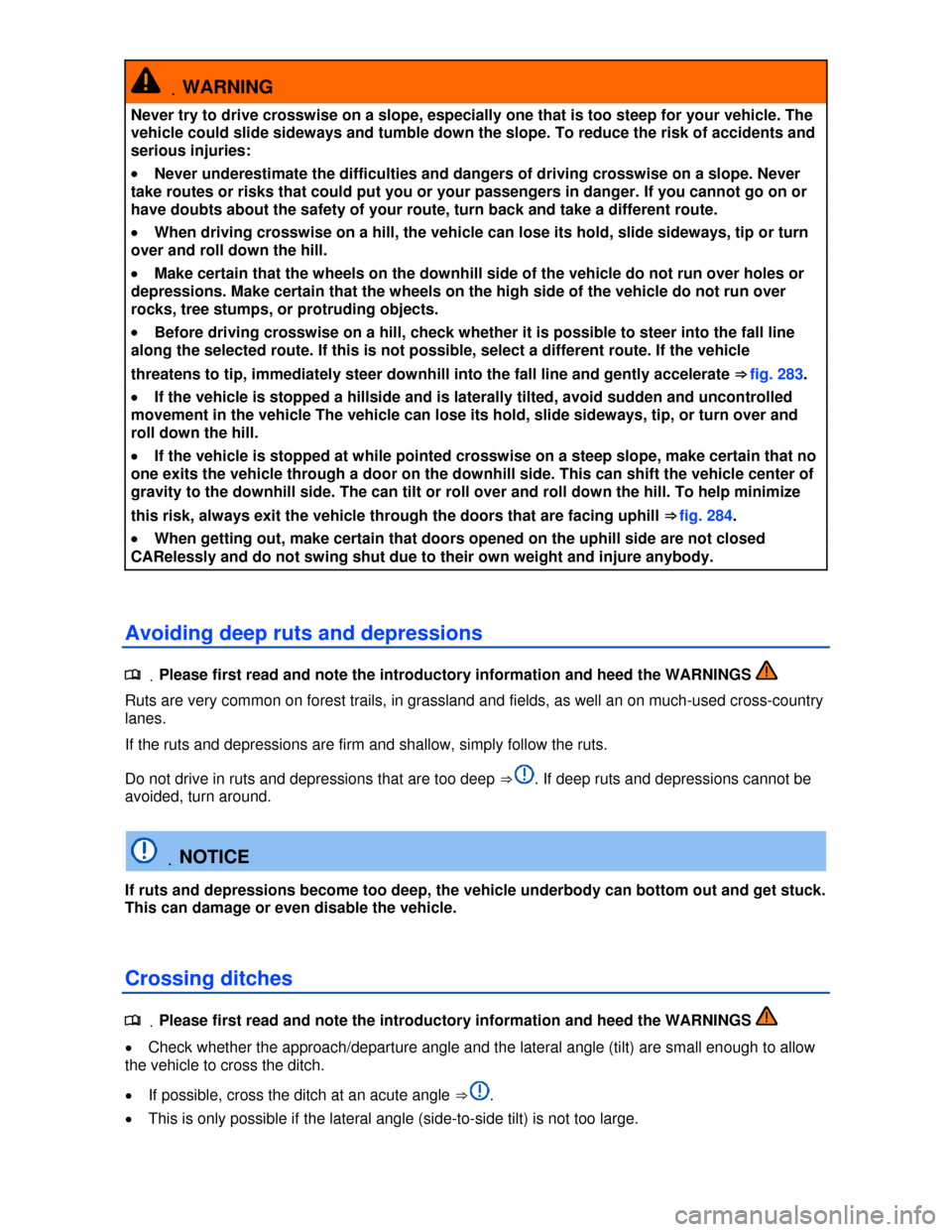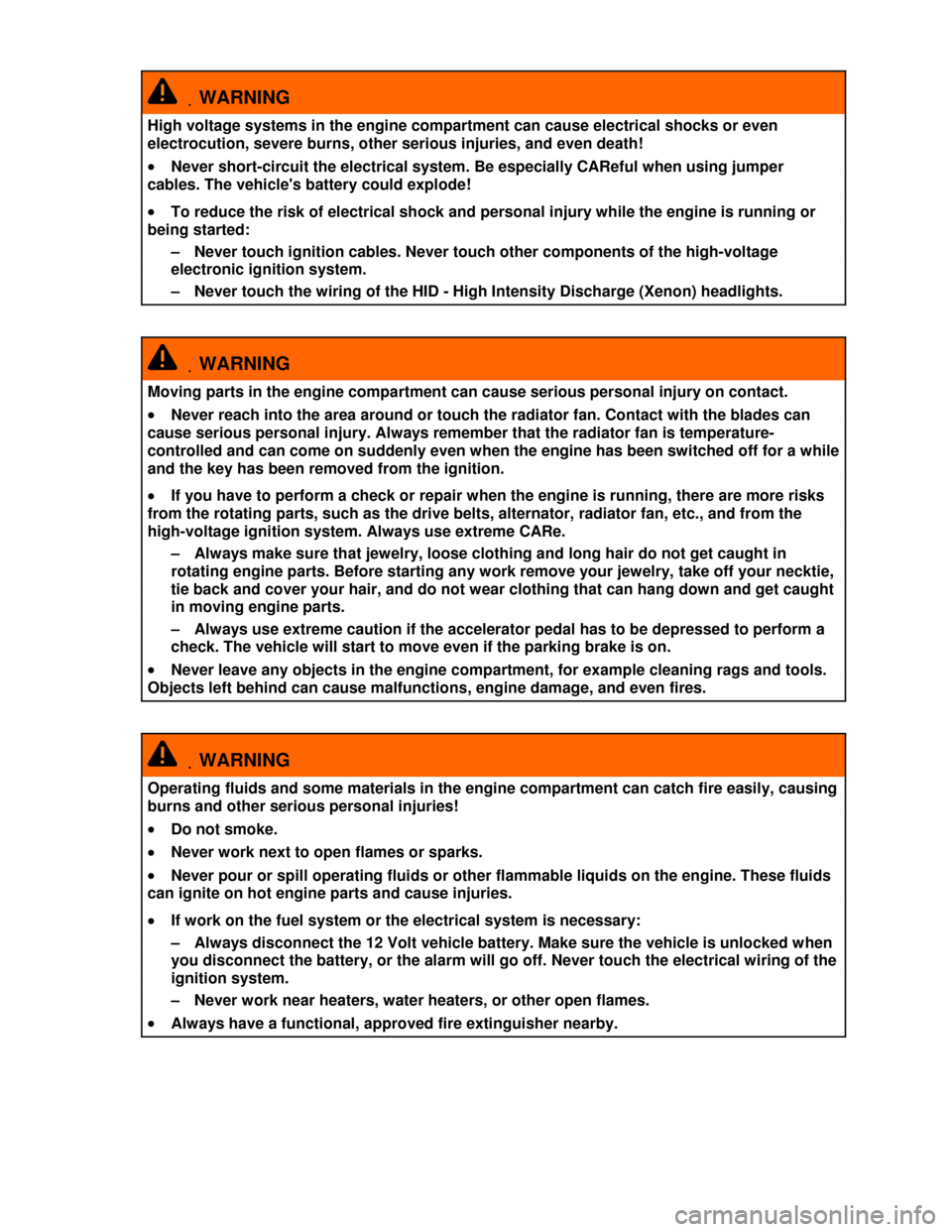Page 420 of 440

Term Explanation Technical data
Ground clearance This is the vertical distance between the
level ground and the lowest part on the
vehicle.
Front: maximum 8.6 inches
(214 mm).
Rear: maximum 10.4 inches
(261 mm).
Fording depth in
standing water
Distance between the point on the ground
that touches the tire and the engine air
intake duct.
Maximum 20 inches (500 mm).
Gradient angle The number of feet (meters) in altitude
gained when traveling 100 ft (30.48 m) is
given as a percentage or in degrees
⇒ fig. 281 A.
Information on the maximum slope the
vehicle can climb unassisted (depends on
road surface and engine power).
Maximum permissible 31 degrees
(corresponds to 60 %).
Lateral angle
(vehicle slope)
The maximum angle the vehicle may be
driven across terrain without the vehicle
rolling over (depends on height of center
of gravity) B.
Maximum permissible
35 degrees.
Breakover angle Maximum permitted angle given in
degrees that a vehicle driven at low speed
can clear a ramp without the underbody of
the vehicle scraping the ramp
Maximum 20 degrees.
Approach/departure
angle
Transition from horizontal plane to a slope,
or from a slope to flat ground.
Maximum angle in degrees the vehicle can
be driven at low speed along an
embankment without the bumper or
underbody scraping.
Front: maximum 25 degrees.
Rear: maximum 26 degrees.
Fall line This is the vertical drop route.
Articulation Articulation capability of the vehicle while driving on one side over an object.
.WARNING
Never exceed the recommended maximum values in the above table. Exceeding these values
will result in serious personal injury and/or damage to your vehicle.
�x All values listed above are for ideal conditions and assume firm, even surfaces that are
dry and not slippery.
�x Off-road conditions will always be less than ideal. Always reduce the maximum values
listed in the table above to allow an adequate margin of safety between the ideal maximum
value and your vehicle's actual off-road situation.
Useful off-road driving equipment
.�
Page 431 of 440

.WARNING
Never try to drive crosswise on a slope, especially one that is too steep for your vehicle. The
vehicle could slide sideways and tumble down the slope. To reduce the risk of accidents and
serious injuries:
�x Never underestimate the difficulties and dangers of driving crosswise on a slope. Never
take routes or risks that could put you or your passengers in danger. If you cannot go on or
have doubts about the safety of your route, turn back and take a different route.
�x When driving crosswise on a hill, the vehicle can lose its hold, slide sideways, tip or turn
over and roll down the hill.
�x Make certain that the wheels on the downhill side of the vehicle do not run over holes or
depressions. Make certain that the wheels on the high side of the vehicle do not run over
rocks, tree stumps, or protruding objects.
�x Before driving crosswise on a hill, check whether it is possible to steer into the fall line
along the selected route. If this is not possible, select a different route. If the vehicle
threatens to tip, immediately steer downhill into the fall line and gently accelerate ⇒ fig. 283.
�x If the vehicle is stopped a hillside and is laterally tilted, avoid sudden and uncontrolled
movement in the vehicle The vehicle can lose its hold, slide sideways, tip, or turn over and
roll down the hill.
�x If the vehicle is stopped at while pointed crosswise on a steep slope, make certain that no
one exits the vehicle through a door on the downhill side. This can shift the vehicle center of
gravity to the downhill side. The can tilt or roll over and roll down the hill. To help minimize
this risk, always exit the vehicle through the doors that are facing uphill ⇒ fig. 284.
�x When getting out, make certain that doors opened on the uphill side are not closed
CARelessly and do not swing shut due to their own weight and injure anybody.
Avoiding deep ruts and depressions
.�
Page 437 of 440

.WARNING
High voltage systems in the engine compartment can cause electrical shocks or even
electrocution, severe burns, other serious injuries, and even death!
�x Never short-circuit the electrical system. Be especially CAReful when using jumper
cables. The vehicle's battery could explode!
�x To reduce the risk of electrical shock and personal injury while the engine is running or
being started:
– Never touch ignition cables. Never touch other components of the high-voltage
electronic ignition system.
– Never touch the wiring of the HID - High Intensity Discharge (Xenon) headlights.
.WARNING
Moving parts in the engine compartment can cause serious personal injury on contact.
�x Never reach into the area around or touch the radiator fan. Contact with the blades can
cause serious personal injury. Always remember that the radiator fan is temperature-
controlled and can come on suddenly even when the engine has been switched off for a while
and the key has been removed from the ignition.
�x If you have to perform a check or repair when the engine is running, there are more risks
from the rotating parts, such as the drive belts, alternator, radiator fan, etc., and from the
high-voltage ignition system. Always use extreme CARe.
– Always make sure that jewelry, loose clothing and long hair do not get caught in
rotating engine parts. Before starting any work remove your jewelry, take off your necktie,
tie back and cover your hair, and do not wear clothing that can hang down and get caught
in moving engine parts.
– Always use extreme caution if the accelerator pedal has to be depressed to perform a
check. The vehicle will start to move even if the parking brake is on.
�x Never leave any objects in the engine compartment, for example cleaning rags and tools.
Objects left behind can cause malfunctions, engine damage, and even fires.
.WARNING
Operating fluids and some materials in the engine compartment can catch fire easily, causing
burns and other serious personal injuries!
�x Do not smoke.
�x Never work next to open flames or sparks.
�x Never pour or spill operating fluids or other flammable liquids on the engine. These fluids
can ignite on hot engine parts and cause injuries.
�x If work on the fuel system or the electrical system is necessary:
– Always disconnect the 12 Volt vehicle battery. Make sure the vehicle is unlocked when
you disconnect the battery, or the alarm will go off. Never touch the electrical wiring of the
ignition system.
– Never work near heaters, water heaters, or other open flames.
�x Always have a functional, approved fire extinguisher nearby.